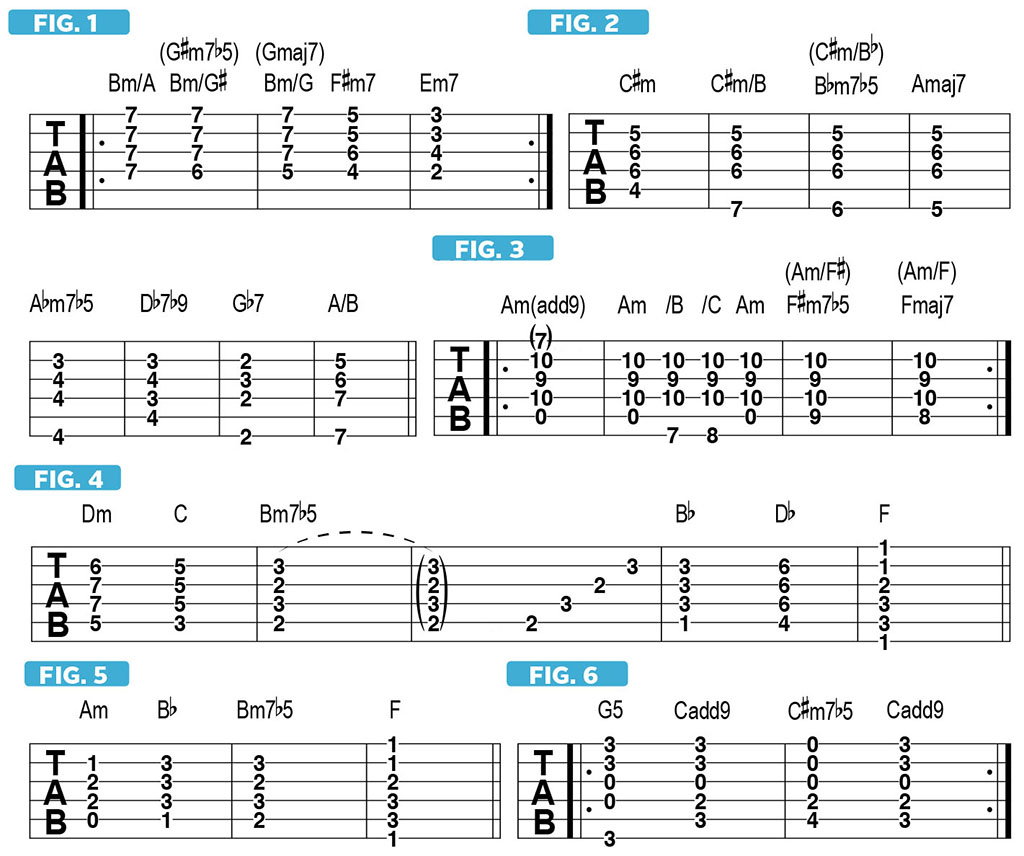Restless Harmony: Meet the Anxious m7b5 Chord
Look at a few examples of ways in which world-renowned songwriters have harnessed this harmonic beast and put it to good use.
Of all the different chord types there are, such as major, minor, dominant seven, sus4 and whatnot, among my favorites is m7b5 (minor seven flat-five), also known as “half-diminished seven.” A rather sophisticated entity, m7b5, which is theoretically spelled “root, minor third, diminished fifth, minor seventh” (or more colloquially, among working musicians, “1, b3, b5, b7”) has a somewhat anxious, restless quality, as it seemingly begs to move on to some other chord. So you would never want to end a song on it, unless you want to mess with people’s heads. As always, the key factor, if your goal is to create appealing music, is placement, meaning how or where you employ the chord within a progression. Let’s look at a few examples of ways in which world-renowned songwriters have harnessed this harmonic beast and put it to good use in a non-jazz context. (We’ll explore that in another lesson.)
The Motown classic “Ain’t No Mountain High Enough,” written by Nickolas Ashford and Valerie Simpson and famously sung by Marvin Gaye and Tammi Terrell, features an interesting variation on the “b7 minor-drop” progression we explored in the April 2018 installment of String Theory. The intro and verses are built around a repeating four-bar harmonic loop in the key of B minor that begins with the bass line dropping from A to G# to G under a high Bm chord, creating the progression Bm/A Bm/G# Bm/G, followed by F#m7 and Em7, as in FIGURE 1. That second chord, which is also called G#m7b5, creates a dramatically suspenseful feeling that may be described as “harmonic angst.” Notice the welcome sense of relief, or release, from the tension on the following chord, which may be also reckoned as Gmaj7.
This signature move — from a m7b5 chord to a maj7 rooted a half step below — can be found in several other well-known songs, such as “Interstate Love Song” by Stone Temple Pilots (which we looked at recently) and “All in Love Is Fair” by Stevie Wonder, both of which are in the key of C# minor and include the chord change Bbm7b5 to A (or Amaj7). FIGURE 2 outlines the latter song’s progression.
Another fine example of this move is the intro to the Foo Fighters song “The Pretender,” wherein guitarist Dave Grohl arpeggiates a fairly high voicing of Am on the D, G and B strings and melds it to a low, melodic bass-line figure that walks up from A to B to C, then to F# before dropping to F, creating the change F#m7b5 to Fmaj7. FIGURE 3 illustrates the basic progression. Again, note the use of common tones.
The chorus to Aerosmith’s “What It Takes” features a similarly dramatic use of a m7b5 chord, specifically at 1:45, where, in the key of D minor, an arpeggiated Bm7b5 becomes the song’s standout guitar hook. In this case, we have, as in FIGURE 4, the chords Dm, C and Bm7b5, the latter of which is held during the lyrics “without thinking you lost everything that was said,” then picked out as twangy single notes before dropping to the more stable-sounding Bb, which then takes a brief, interesting detour to Db before finally resolving to F.

Coming literally from the opposite direction — below — Sir Paul McCartney famously used this same Bm7b5 chord in the key of F in his Wings ballad “My Love,” specifically at the end of each verse, where he employed it to create a breathtaking harmonic crest behind the lyric “My love does it good.” As in FIGURE 5, the chord is preceded by Am and Bb and followed by a stable sounding F, the “one” chord.
The chorus to “All Star” by Smash Mouth offers another good example of a m7b5 chord’s tasteful usage in a pop song, again approached from a major chord a half step below. Playing in the key of G (but with his instrument tuned down a half step), guitarist Greg Camp makes effective use of his open strings to strum, behind the lyric “get your game on,” a rich-sounding C#m7b5 voicing, which he both precedes and follows with Cadd9, using the shapes shown in FIGURE 6.
All the latest guitar news, interviews, lessons, reviews, deals and more, direct to your inbox!
Senior Music Editor "Downtown" Jimmy Brown is an experienced, working musician, performer and private teacher in the greater NYC area whose professional mission is to entertain, enlighten and inspire people with his guitar playing.
Over the past 30 years, Jimmy Brown has built a reputation as one of the world's finest music educators, through his work as a transcriber and Senior Music Editor for Guitar World magazine and Lessons Editor for its sister publication, Guitar Player. In addition to these roles, Jimmy is also a busy working musician, performing regularly in the greater New York City area. Jimmy earned a Bachelor of Music degree in Jazz Studies and Performance and Music Management from William Paterson University in 1989. He is also an experienced private guitar teacher and an accomplished writer.

